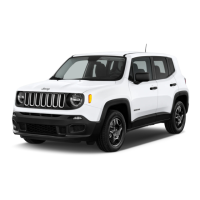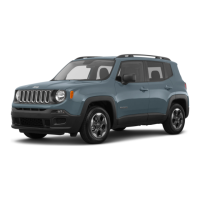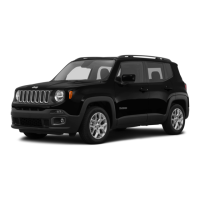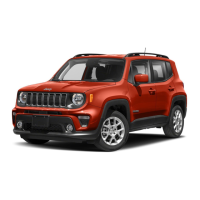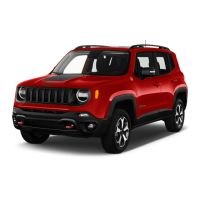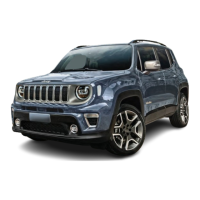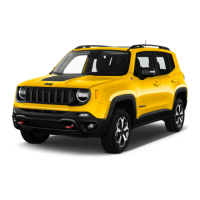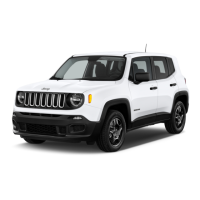
Do you have a question about the Jeep Renegade 2015 and is the answer not in the manual?
| Brand | Jeep |
|---|---|
| Model | Renegade 2015 |
| Category | Automobile |
| Language | English |
Explains how to navigate and understand the owner's manual for optimal use.
Highlights critical warnings and cautions to prevent collisions, injury, or vehicle damage.
Warns about the higher rollover risk of utility vehicles and safe driving practices.
Provides tips for preparing for service appointments and interacting with service advisors.
Offers contact information and procedures for seeking assistance from FCA US LLC and FCA Canada Inc.
Directs users to the Warranty Information Booklet for terms and provisions applicable to the vehicle.
Instructs on how to report vehicle safety defects to NHTSA and Transport Canada.
Explains tire grading categories for treadwear, traction, and temperature.
Illustrates and labels key components visible from the front exterior of the vehicle.
Illustrates and labels key components visible from the rear exterior of the vehicle.
Identifies and labels various controls and indicators on the vehicle's instrument panel.
Illustrates and labels key interior features and controls, including seats and climate controls.
Explains the vehicle's key system, including key fobs and keyless entry features.
Details the operation of the ignition switch and its various positions for starting and operating the vehicle.
Explains the functionality and operation of the remote starting system for convenience and comfort.
Describes how the vehicle security alarm monitors and alerts for unauthorized entry or ignition cycles.
Covers manual and central locking systems, keyless entry, and child protection locks for vehicle doors.
Explains manual and power seat adjustments, including heated seats and rear seat folding.
Details the purpose and adjustment of front and rear head restraints for occupant safety.
Covers tilt/telescoping steering column adjustment and heated steering wheel features.
Explains adjustment and features of inside day/night mirrors and auto-dimming mirrors.
Describes the BSM system's function in detecting vehicles in blind spots and its operation modes.
Covers operation of headlights, automatic lighting, daytime running lights, fog lights, and parking lights.
Explains operation of front and rear interior lights, including dome light timing.
Details power window operation, including auto-down/up features and lockout switches.
Explains air outlet locations, manual, and automatic climate control system operations.
Provides instructions for removing/installing roof panels and operating power sky roof features.
Details the procedure for opening the vehicle's hood.
Explains how to open and close the liftgate, including emergency opening procedures.
Covers features like glove compartment, sun visors, power outlets, cigar lighter, and ashtray.
Provides precautions and guidelines for using the roof luggage rack for transporting accessories.
Explains the instrument cluster layout and multi-functional displays (EVIC/DID).
Details the speedometer function and how to adjust instrument panel illumination.
Describes the odometer display and regulations regarding mileage recording for ownership transfer.
Describes the digital fuel gauge and the low fuel warning indicators.
Explains the function of the temperature gauge and precautions for hot engines.
Lists and explains various warning lights and messages displayed in the EVIC/DID instrument cluster.
Describes the OBD II system's role in monitoring vehicle performance and emission controls.
Explains the EVIC/DID displays and their descriptions, including menu options and control buttons.
Details the dual hydraulic brake systems, warning lights, and safety precautions for brake usage.
Explains ESC, TCS, BAS, ERM, HSA, and HDC systems for enhanced directional control and stability.
Describes ABS function in maintaining vehicle control under adverse braking conditions and its self-test procedure.
Explains TCS operation in monitoring wheel spin and applying brake pressure for stability.
Details BAS function in optimizing braking capability during emergency maneuvers and its interaction with ABS.
Covers seat belt systems, supplemental restraint systems (SRS) airbags, and child restraints.
Provides crucial steps to minimize harm from airbag deployment and ensure passenger safety.
Explains the importance of seat belt usage, including the BeltAlert reminder system.
Provides recommendations for restraining children in vehicles, including types of restraints and installation.
Instructions for starting the engine, including manual and automatic transmission procedures and fail-safe measures.
Guidelines for breaking in the engine and drivetrain for optimal performance and longevity.
Explains the operation of the EPB system, including manual and automatic engagement, release, and safety precautions.
Details shifting procedures, recommended shift speeds, and downshifting techniques for manual transmissions.
Covers shift lever operation, gear ranges, and transmission limp home mode for automatic transmissions.
Explains cruise control activation, setting, deactivation, and varying speed functions.
Describes the automatic 4WD system and Selec-Terrain™ modes for various driving conditions.
Explains FCW system operation, including warnings, limited braking, and sensitivity adjustments.
Details LaneSense operation, including lane departure warnings, status changes, and steering wheel feedback.
Explains the rear park assist system's indications, sensors, and chime behavior for parking assistance.
Describes the backup camera's image, guide lines, and display options for parking assistance.
Explains TPMS warnings for low tire pressure, system faults, and tire maintenance recommendations.
Covers fuel recommendations for engines, including octane ratings and gasoline blends.
Details the capless fuel system operation and emergency refueling procedures.
Provides information on certification labels, weight ratings (GVWR, GAWR), payload, and loading precautions.
Advice for driving utility vehicles on paved roads, emphasizing safe cornering and handling.
Guidance for off-road driving, including 4WD LOW usage, driving through water, and hill climbing.
Explains electric power steering system operation, assist levels, and fault indications.
Covers safety tips, definitions, hitch classifications, towing weights, requirements, and trailer lights/wiring.
Guidelines for towing the vehicle behind another vehicle, including FWD and 4WD models.
Explains the operation and use of hazard warning flashers as an emergency warning system.
Details the functionality of ASSIST and 9-1-1 buttons for accessing support and emergency services.
Provides general information and specific instructions for replacing interior and exterior vehicle bulbs.
Covers general information about fuses, access locations, and detailed fuse box diagrams.
Offers warnings and instructions for safely jacking the vehicle and changing a tire.
Explains the location and components of the tire service kit for emergency repairs.
Provides instructions and precautions for safely jump-starting a vehicle with a discharged battery.
Describes the system's functions after an impact, such as cutting fuel and flashing hazard lights.
Offers actions to reduce engine overheating potential, such as slowing down or shifting to neutral.
Provides a procedure to temporarily move the shift lever if it cannot be moved out of PARK.
Explains how to manually remove the ignition key when the transmission is locked in PARK.
Offers tips for freeing a stuck vehicle using a rocking motion and proper transmission shifting.
Describes procedures for towing a disabled vehicle using commercial towing services, including FWD and 4WD models.
Explains the location and usage of emergency tow hooks for vehicle recovery.
Explains emissions inspection requirements and the role of the Malfunction Indicator Light (MIL).
Recommends using genuine parts for maintenance and repairs to ensure performance and warranty coverage.
Highlights the availability of qualified service personnel and specialized tools at authorized dealerships.
Details the automatic oil change indicator system and provides a maintenance chart with intervals.
Identifies and labels key components within the engine compartment for the 1.4L Turbo engine.
Identifies and labels key components within the engine compartment for the 2.4L engine.
Covers essential maintenance procedures like checking engine oil, filters, and fluids.
Explains how to check engine oil level and procedures for changing engine oil.
Recommends using MOPAR engine oil filters for optimal service and efficiency.
Refers to the maintenance schedule for proper intervals regarding engine air cleaner filter replacement.
States that the vehicle is equipped with a maintenance-free battery requiring no periodic water addition.
Advises checking and servicing the air conditioner annually for optimal performance.
Details periodic lubrication points for locks, hinges, and other body components.
Provides instructions for cleaning wiper blades and avoiding damage from dry operation or frost.
Emphasizes maintaining the exhaust system for protection against carbon monoxide entry.
Covers coolant checks, drain/flush/refill procedures, and warnings about hot cooling systems.
Stresses the importance of periodic inspection of brake system components and warns against riding the brakes.
Explains common causes of vehicle corrosion, such as road salt and atmospheric pollutants.
Provides guidelines for regularly washing the vehicle using mild soap and water.
Offers advice on cleaning specific vehicle parts like stone chips, painted surfaces, and wheels.
Recommends regular cleaning of wheels and trim to prevent corrosion.
Provides cleaning instructions for fabric, vinyl, and leather upholstery using MOPAR products.
Covers tire markings, identification numbers, terminology, loading, pressure, and types.
Discusses tire pressure, its impact on safety, economy, tread wear, and ride comfort.
Explains tread wear indicators and their role in determining when tires need replacement.
Lists factors affecting tire service life, including driving style, pressure, and distance.
Recommends using equivalent tires in size and quality for replacement and warns against using incorrect sizes.
Provides recommendations for using traction devices, including size, installation, and clearance.
Explains the importance of tire rotation for balancing wear and maintaining traction.
Offers precautions for storing the vehicle for extended periods, including battery care and brake engagement.
Provides information on the location of the chassis number (VIN) on the vehicle.
Details proper lug nut/bolt torque specifications for wheel mounting and inspection of the mounting surface.
Lists approximate fluid capacities for fuel, engine oil, and cooling system in U.S. and Metric units.
Recommends specific fluids, lubricants, and genuine parts for engine and chassis components.
Explains how to access and change customer-programmable features using touchscreen and faceplate buttons.
Refers to the Uconnect® Radio Supplement for detailed radio information and operation.
Describes connecting external devices via USB port or AUX Jack for media playback.
Explains the function of remote sound system controls located on the steering wheel.
Details how to use radio controls for seeking stations and tuning presets.
Explains how to navigate media tracks using touchscreen controls for AUX, USB, and Bluetooth®.
Offers helpful tips and key voice commands for controlling the Uconnect® system.
Guides users on how to begin using the Uconnect® system with steering wheel controls and reduce background noise.
Lists basic voice commands for controlling the Uconnect® system, including cancel, help, and repeat.
Explains display settings like Display Mode, Brightness, Language, and Touchscreen Beep.
Allows selection of measurement units for EVIC/DID, including distance, fuel consumption, tire pressure, and temperature.
Covers voice settings like Response Length and Show Command List for system interaction.
Details settings for managing the clock display, including time, date, and format.
Explains features like Forward Collision Warning (FCW) and LaneSense for driver assistance.
Explains auto door locks, auto unlock on exit, flash lights with lock, sound horn with lock, and passive entry features.
Details engine off power delay settings for accessories like power windows and radio.
